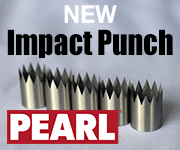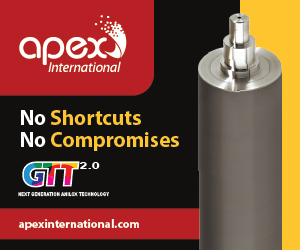Enhance Surface Performance with Corona Treatment in Printing and Laminating Applications
- Published: July 20, 2025

Converters working with plastic films like polyethylene or polypropylene often face poor surface receptivity. Whether bonding layers through lamination or seeking crisp, consistent print quality, low surface energy materials can result in poor adhesion or print quality, delamination or other defects in the finished product.
Corona treatment is widely used to overcome these limitations. By modifying the surface characteristics of a material, corona discharge increases wettability, improves adhesion, and creates a more receptive surface for inks, coatings and adhesives.
Converters can integrate this technology into their production lines for better process reliability and product performance to reap the full benefits of corona treatment in laminating and printing applications.
Understanding Surface Tension
Surface tension, measured in dynes/cm, measures the force per unit length acting at the surface of a liquid, determining a liquid's ability to wet a solid. Surface energy (mJ/m2) is sometimes called solid surface tension and reflects a material's adhesion potential.
The "wettability" of a liquid is its ability to spread across a solid surface. It is a characteristic of the interaction of the liquid and solid materials and the environmental conditions in which the interaction occurs. For a liquid to have good wettability, its surface tension must be lower than the surface tension of the solid to which is being applied.
Several methods exist to evaluate the surface tension of a material:
Contact angle testing involves measuring the angle between the surface of a droplet and the material on which it is dropped. A contact angle greater than 90° indicates poor wetting, while a contact angle is less than 90° indicates good wetting. This method offers precise, quantifiable data but requires specialized equipment like an optical goniometer and is more time- and labor-intensive.
Dyne testing involves applying test inks of known surface tension to the material using a dyne pen, brush or swab. If the ink beads over a two-second observation, the ink has a higher surface tension than the material. The operator repeats the process with higher dyne-level inks until one wets out evenly, giving an approximate measure of surface energy. This method is low-cost and more practical for production environments, but results can vary based on technique and interpretation, and the tested material is no longer usable. However, dyne testing offers a quick, practical way to assess a material - especially useful for comparing to established benchmark for a material.
How Corona Treatment Works
Corona treatment begins when air is exposed to a high voltage electrical discharge and oxygen is ionized to form ozone. Ozone breaks and reorganizes the molecular bonds on the surface of the material being treated, increasing its surface energy and making it more receptive to adhesives, coatings and inks.
Corona treating can typically increase the surface tension of a polyolefin film 10 dyne levels (from 32 to 42 dynes/cm, to give a sense of scale) or higher, depending on the material and process parameters.
Corona treaters come in a variety of sizes and configurations, from sheet treaters to narrow and wide-web roll treaters. The size, voltage, electrode material and overall configuration are specified for the material being treated to ensure optimal treatment. Power supplies range from 500W for a narrow web to 40kW for a wide web being treated at increased speeds. Systems can be configured for conductive or non-conductive materials, as well as single- or double-sided treatment, accommodating virtually any treating challenge.
 Benefits in Lamination and Printing
Benefits in Lamination and Printing
Corona treatment provides several benefits that contribute to superior lamination, improved printing quality and greater process efficiency.
The primary advantage of enhanced adhesion is preventing delamination, thereby preserving the integrity of laminated material throughout the application's lifecycle. Improved wettability expands compatibility with both solvent-based and water-based adhesives previously limited by low surface energy. This enables the use of adhesives offering increased clarity, improved gas permeability qualities, and enhanced physical and chemical properties.
Similarly, corona treatment improves print quality and broadens ink options. It reduces common defects such as smudging, flaking and fading, and can improve resolution in flexo, gravure and digital printing. By overcoming low surface energy limitations, expanded options for inks can reduce defects and present more environmentally friendly solutions.
Additionally, improved wettability can eliminate chemical primers and other surface pre-treatments, simplifying production, reducing processing time and lowering overall production costs.
Integrating Corona Treatment into a Line
While some materials arrive pretreated or undergo bump treatment by the manufacturer, the effectiveness of corona treatment can diminish over time. Decay rates vary based on the material, manufacturer, handling practices and environmental conditions, ranging from days to months. Incorporating an inline corona treater into your printing or laminating process ensures consistent surface energy at the point where adhesion or printing occurs.
A corona treater is typically about 30 percent wider than the treat width, with an infeed-to-outfeed length less than half that width, making it relatively compact and easy to install. Whether integrating into a new or existing line, the treater should be positioned immediately before the critical process-such as lamination, coating, or printing — for maximum effectiveness. While the effect of the treatment will not degrade immediately, placing the treater close to the application station ensures peak surface energy and minimizes the risk of contamination from dust, oils or slip agents.
Power requirements scale with system size, but many treaters operate on 208/240V and use a transformer to step up voltage for the high-frequency discharge. Smaller systems can even run on standard 120V outlets. Transformers can be integrated with the treater or mounted remotely and tethered to the power supply.
Because corona treatment generates ozone, proper ventilation is essential. A common guideline is 100 CFM of airflow per kilowatt of power. For larger systems or where required by local regulations, ozone destruct units can be added. These catalytic systems reduce ozone emissions to below 0.1 ppm, aiding in compliance with workplace safety and environmental emissions requirements.
About the Author
John Kalinowsky is an electro-mechanical project engineer for Corotec. His duties include developing solutions to meet industry needs, overseeing projects through production, and supporting customers and equipment. Contact John at (860)357-6204 or jkalinowsky@corotec.com to discuss Corotec's corona treatment solutions.












